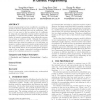229 search results - page 7 / 46 » Potential fitness for genetic programming |
CEC
2010
IEEE
12 years 11 months ago
2010
IEEE
— If a population of programs evolved not for a few hundred generations but for a few hundred thousand or more, could it generate more interesting behaviours and tackle more comp...
GECCO
2010
Springer
13 years 7 months ago
2010
Springer
To complement standard fitness functions, we propose "Fitness Importance" (FI) as a novel meta-heuristic for online learning systems. We define FI and show how it can be...
IWMM
2000
Springer
13 years 11 months ago
2000
Springer
Dynamic memory allocation is an important part of modern programming languages. It is important that it be done fast without wasting too much memory. Memory allocation using lazy ...
GECCO
2006
Springer
13 years 11 months ago
2006
Springer
Genetic programming has been considered a promising approach for function approximation since it is possible to optimize both the functional form and the coefficients. However, it...
FLAIRS
2006
13 years 9 months ago
2006
We propose to improve the efficiency of genetic programming, a method to automatically evolve computer programs. We use graph-based data mining to identify common aspects of highl...



